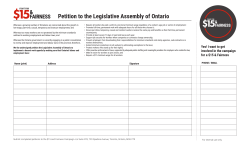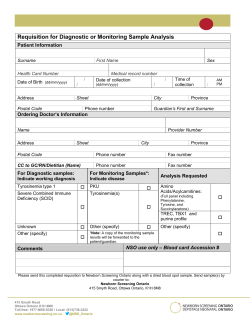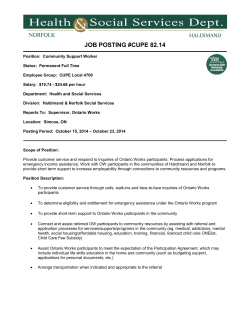
Use of Quit Aids Among Ontario Smokers
March 2015
Use of Quit Aids Among Ontario Smokers
Research shows that smokers who use quit aids such as
Key Message: Less than
pharmacotherapies and behavioral support are more likely to be
50% of Ontario smokers
successful in smoking cessation than smokers who do not use quit
use quit aids when trying
aids. 1,2,3,4.5 First line pharmacotherapies for smoking cessation include
to quit.
nicotine replacement therapy (NRT), bupropion, and varenicline.
Behavioural support may include individual or group counselling, aids
from telephone or online quitlines, self-help materials and attendance
at quit programs. 6,7,8 Little is known, however, about who uses cessation aids and how the use of
cessation aids has changed over time in Ontario. This update explores factors related to use and trends
in the use of various cessation aids over time among Ontario smokers who made a quit attempt, using
data from the Ontario Tobacco Research Unit’s Ontario Tobacco Survey (OTS).
The Ontario Tobacco Survey collected information from a random sample of 4,500 Ontario adult smokers
between 2005 and 2011. These participating smokers were followed every 6 months for up to 3 years.
Information about quit attempts and use of quit aids in the previous 6 months was collected.
Among all participating smokers, 2,527 (57%) smokers made a quit attempt (i.e., tried to quit completely
or stopped smoking for at least 24 hours) during the three year follow-up. Of these quit attempters, 48%
used at least one type of quit aids (NRT: 32%, varenicline: 9%, bupropion: 8%, behavioral support: 19%,
and self-help materials: 18%), while 52% did not use any of these. Among smokers who made a quit
attempt and used any quit aids, the majority (66%) used NRT, 40% used behavioural support, 19% used
varenicline, 17% used bupropion, and 37% used self-help materials during the overall follow-up period
(note: some smokers used more than one type of quit aid, so the sum of these percentages is larger than
100%).
Trends in Use
Among quit attempters, use of NRT was relatively higher initially at 23% in the period of January -June
2006, then dropped to 11% in January-June 2009; NRT use declined significantly by 1.9 percentage
points per every 6 months (p for trend <0.01) during the period of January 2006-June 2009. After June
2009, use of NRT increased to 18% in July-December 2009 and stayed relatively stable after Jan 2010.
Use of bupropion was relatively low over the survey period, from 6.4% at the beginning of data
collection to 3.4% at the end, while the lowest use was 1.7% in July-December 2009. Use of bupropion
Ontario Tobacco Research Unit
1
Use of Quit Aids among Ontario Smokers
declined significantly during the overall survey period of January 2006-June 2011 by 0.32 percentage
points per every 6 months (p for trend <0.05), especially before January 2010, declining by 0.63
percentage points per every 6 months (p for trend <0.01).
Use of varenicline began in 2007 when the medication was introduced in Ontario. Initially, use of
varenicline was low at 2.8%; it increased to 5.3% in a year and to 6.2% two and a half years later; and
then dropped to 2.7% at the end of the survey period. There was no significant change in use of
varenicline during any period or the overall survey period (p for trend >0.05).
Use of behavioral support excluding self-help materials was relatively high initially at 9% in JanuaryJune 2006, but declined significantly from January-June 2006 to 4.8% in July-December 2007 (p for trend
<0.05); after that period, use of behavioral support increased significantly to 9.3% in January-June 2011
(p for trend <0.01).
Use of self-help materials increased from 6.9% at the beginning of the survey to 9.5% during JulyDecember 2007 by 0.81 percentage points per every 6 months (p for trend <0.05) and then decreased
from that period to 6.5% at the end of the survey by 0.44 percentage points per every 6 months (p for
trend <0.01) (Figure 1).
Figure 1: Use of Cessation Aids Among Smokers Who Made a Quit Attempt, Ontario, 18+, January 2006-June 2011
30%
NRT
Self-help materials
25%
23.0%
Behavioral support
21.6%
Varenicline
Bupropion
20%
17.7%
15.4%
14.7%
15%
12.6%
13.4%
13.5%
14.2%
14.3%
11.1%
10%
9.0%
6.9%
5%
6.4%
8.3%
7.7%
5.6%
8.6%
9.5%
7.2%
5.4%
4.8%
Jul-Dec
2006
5.4%
5.3%
4.8%
5.3%
5.3%
2.8%
2.8%
2.5%
2.6%
Jan-Jun
2007
Jul-Dec
2007
Jan-Jun
2008
4.1%
0%
Jan-Jun
2006
9.2%
Ontario Tobacco Research Unit
Jul-Dec
2008
7.8%
5.4%
7.9%
7.7%
6.2%
4.0%
2.6%
Jan-Jun
2009
1.7%
Jul-Dec
2009
9.3%
7.8%
6.9%
5.4%
2.0%
Jan-Jun
2010
7.5%
6.2%
5.1%
6.5%
3.4%
2.7%
2.7%
Jul-Dec
2010
Jan-Jun
2011
2
Use of Quit Aids among Ontario Smokers
Factors Related to Use
Multivariable logistic regression was used to examine factors related to the use of various cessation
aids. Compared to those who did not use any quit aids:
•
•
•
•
•
Those who used NRT for smoking cessation during follow-up were more likely to be female and
daily smokers, rated their health as poor-fair, and lived in Northern Ontario, but they were less
likely to be single.
Those who used varenicline were more likely to be female and daily smokers, with a moderate or
high Heaviness of Smoking Index (HSI) score, and lived in Southwest Ontario and Northern
Ontario, but were less likely to be single.
Those who used bupropion were more likely to be female, with a moderate or high HSI score,
and lived in Northern Ontario, but were less likely to be single.
Those who used behavioral support were more likely to be female, with a moderate HSI score,
and rated their health as poor-fair, but were less likely to be single.
Those who used self-help materials were more likely to be female, highly educated and daily
smokers, rated their health as poor-fair, and lived in Northern Ontario, but were less likely to be
single (Table 1).
Table 1: Factors Significantly Associated with Use of Quit Aids Among Smokers Who Made a Quit Attempt During
Follow-Up, Ontario, 18+, January 2006 – June 2011
Use of Quit Aids
Factors
NRT
Female vs. male
1.37 (1.04-1.79)*
Single vs. married
0.57 (0.39-0.81)**
Poor-fair vs. good-excellent health
1.69 (1.18-2.43)**
Daily vs. non-daily smoking
Varenicline
Bupropion
Adjusted OR (95% CI)†
10.22 (2.44-42.83)**
Northern Ontario vs. Toronto
1.90 (1.35-2.68)***
Female vs. male
1.78 (1.17-2.71)**
Single vs. married
0.27 (0.15-0.48)***
Daily vs. non-daily smoking
7.13 (1.47-34.69)*
HSI: moderate vs. low
3.66 (2.33-5.75)*
HSI: high vs. low
4.12 (2.06-8.21)*
Southwest Ontario vs. Toronto
2.24 (1.28-3.91)*
Northern Ontario vs. Toronto
2.27 (1.30-3.97)*
Female vs. male
1.71 (1.11-2.64)*
Single vs. married
0.36 (0.19-0.70)*
HSI: moderate vs. low
3.06 (1.89-4.95)*
HSI: high vs. low
3.32 (1.63-6.74)*
Ontario Tobacco Research Unit
3
Use of Quit Aids among Ontario Smokers
Behavioral support
Self-help materials
Northern Ontario vs. Toronto
1.87 (1.06-3.27)*
Female vs. male
1.61 (1.17-2.21)**
Single vs. married
0.52 (0.33-0.81)**
Poor-fair vs. good-excellent health
1.68 (1.10-2.55)*
HSI: moderate vs. low
1.55 (1.05-2.30)*
Female vs. male
1.44 (1.04-2.00)*
Post-secondary vs. high school or less
1.46 (1.03-2.06)*
Single vs. married
0.51 (0.33-0.80)**
Poor-fair vs. good-excellent health
1.69 (1.12-2.57)*
Daily vs. non-daily smoking
8.40 (2.24-31.49)**
Northern Ontario vs. Toronto
1.57 (1.06-2.33)*
CI, confidence interval; HSI, heaviness of smoking index; OR, odds ratio.
* p<0.05; ** p<0.01; ***p<0.001.
† Factors in logistic regression model included age, gender (male vs. female), marital status (single, divorced/separated/widowed vs.
married), education (high school or less, vs. post-secondary education), living area (urban vs. rural), region (Southwest Ontario, Eastern
Ontario, Northern Ontario vs. Toronto), perceived health (poor-fair vs. other health), concerns of the cost of quit aids (too high vs.
about right), smoking status (daily vs. non-daily), and heaviness of smoking index.
Conclusions
More than half of Ontario smokers did not use any quit aids when making a quit attempt. Previous
studies show that many smokers underestimate the effectiveness of smoking cessation medication
and/or behavioral support, 9,10,11 and have concerns about the safety of these medications, such as
“nicotine can cause a heart attack or cancer,” 12 and “NRT was as harmful as cigarettes”.11 Some
smokers may not know about the existence of smoking cessation medication and behavioral support.
Education programs may be needed to increase smokers’ awareness of the availability of effective
smoking cessation aids and to provide them with better knowledge and a more positive attitude toward
effective cessation aids. Promoting use of effective cessation aids among males, single persons, those
who do not rate their health as poor, non-daily smokers or non-heavy smokers, and persons living in
Toronto is specifically needed. Offering opportunities to reluctant smokers to try effective cessation
methods in trial or community programs may be a way to improve knowledge about the safety and
efficacy of these methods, and eventually increase smoking cessation among Ontario smokers.
Authors: Bo Zhang and Michael Chaiton
Ontario Tobacco Research Unit
4
Use of Quit Aids among Ontario Smokers
References
Stead LF, Hartmann-Boyce J, Perera R, Lancaster T. Telephone counselling for smoking cessation. Cochrane
Database Systematic Review 2013;8:CD002850.
1
Lancaster T, Stead LF. Individual behavioural counselling for smoking cessation. Cochrane Database
Systematic Review 2005;(2):CD001292.
2
Stead LF, Perera R, Bullen C, et al. Nicotine replacement therapy for smoking cessation. Cochrane Database
Systematic Review 2012;11:CD000146.
3
4
Hughes JR, Stead LF, Hartmann-Boyce J, Cahill K, Lancaster T. Antidepressants for smoking cessation.
Cochrane Database Systematic Review 2014;1:CD000031.
5
Cahill K, Stevens S, Perera R, Lancaster T. Pharmacological interventions for smoking cessation: an overview
and network meta-analysis. Cochrane Database Systematic Review 2013;5:CD009329.
Hartmann-Boyce J, Lancaster T, Stead LF. Print-based self-help interventions for smoking cessation. Cochrane
Database Systematic Review 2014;6:CD001118.
6
7
Naughton F, Jamison J, Boase S, et al. Randomized controlled trial to assess the short-term effectiveness of
tailored web- and text-based facilitation of smoking cessation in primary care (iQuit in practice). Addiction
2014;109:1184-93.
8
Murray RL, Szatkowski L, Ussher M. Evaluation of a refined, nationally disseminated self-help intervention for
smoking cessation ("quit kit-2"). Nicotine and Tobacco Research 2013;15:1365-71.
9
Etter JF, Perneger TV. Attitudes toward nicotine replacement therapy in smokers and ex-smokers in the
general public. Clinical Pharmacolology and Therapeutics 2001;69:175-83.
10
Hammond D, McDonald PW, Fong GT, Borland R. Do smokers know how to quit? Knowledge and perceived
effectiveness of cessation assistance as predictors of cessation behaviour. Addiction 2004;99:1042-8
11
Shiffman S, Ferguson SG, Rohay J, Gitchell JG. Perceived safety and efficacy of nicotine replacement
therapies among US smokers and ex-smokers: relationship with use and compliance. Addiction 2008;103:13718.
12
Bansal MA, Cummings KM, Hyland A, Giovino GA. Stop-smoking medications: who uses them, who misuses
them, and who is misinformed about them? Nicotine and Tobacco Research 2004;Suppl 3:S303-10.
Ontario Tobacco Research Unit
5
© Copyright 2025









